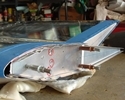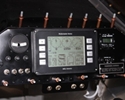


random user submitted photo
Aerovee Turbo coolant leak
8 posts
• Page 1 of 1
Aerovee Turbo coolant leak
I recently acquired a completed Model-A, with the Aerovee turbo. There a small coolant leak from the turbo that appears to be coming from the fitting that is against the firewall, and I noticed that this fitting can be rotated easily by moving the hose back and forth, but it's not really accessible. Can anyone comment on this fitting? Is it attached by a grommet or a fixed fitting? I'm not sure if this is where the leak is coming from, but it's a possibility. The leak disappears when the engine is running, but it drips after the engine is stopped. Any help from other Aerovee turbo owners would be appreciated.
-Patrick Duffy
-Patrick Duffy
- pduffy
- Posts: 6
- Joined: Thu Sep 05, 2024 8:05 pm
Re: Aerovee Turbo coolant leak
I think your description is too vague. If you post a couple of pictures of the offending fitting you will get a lot of suggestions from the forum.
Lou Pappas
Phoenix, AZ
RV-7A Flying (2024)
Waiex B Turbo (2016)
RV-8 (2009)
Waiex Legacy 3300 (2007)
Hiperlight SNS-9 (1991)
Falcon Ultralight (1989)
Phoenix, AZ
RV-7A Flying (2024)
Waiex B Turbo (2016)
RV-8 (2009)
Waiex Legacy 3300 (2007)
Hiperlight SNS-9 (1991)
Falcon Ultralight (1989)
- pappas
- Posts: 356
- Joined: Wed Feb 15, 2017 11:27 am
Re: Aerovee Turbo coolant leak
Here's a photo of where I think the leak is coming from. I can rotate this fitting by moving the hose. Since I didn't build this engine, I don't know how it's connected to the turbo. If it's a threaded fitting, I assume it should be tight, not easily rotated by hand. If anyone knows about this issue, I'd appreciate some input. Seems like the engine would need to be moved to get to this fitting as it's trapped against the firewall.
Thanks,
Patrick
Thanks,
Patrick
- pduffy
- Posts: 6
- Joined: Thu Sep 05, 2024 8:05 pm
Re: Aerovee Turbo coolant leak
2 more pictures would be helpful. One each from the left and right side of the fitting and from a bit farther away as to show more of the surrounding area. I also don't know what part of the fitting is rotating exactly. However, I can tell you that The blue/red fitting in your image should not rotate at all. If the Blue female nut is rotating on the red male hose end, then it is not tight enough. If the hose clamp is not tight enough on the lower hose, then the hose could rotate on the female hose end fitting, (less likely due to the friction of the hose on the barbed fitting end). Still, the clamp needs to be tight.
It is difficult to see exactly how the upper hose is attached to the blue female nut.
(Sidenote- Is the upper blue female nut attached to a metal threaded elbow that threads into the turbo body?) If so, that can be a source of the leak as well. If you are saying that the upper blue female nut is attached to a metal elbow, and, it is that elbow that rotates where it threads into the turbo...that would likely be your leak. If the elbow threads into the turbo body it has to be tight and should have an appropriate thread sealant on those threads as well. It is best to tie the plane down, turn on the cooling pump, and run it with a safety pilot in the cabin and you can watch the fittings under varying RPM settings to see if you can spot the leak occurring. You might be able to get away with just running the cooling pump and not running the engine. Try that first, you can do that alone.
Remember, a lot of leaks start somewhere else, follow the pull of gravity or the direction of the airflow, and manifest themselves in another location.
These aluminum hose fittings can be a source of the leak and should be inspected to make sure they are not loose nor too close to anything that gets hot enough to melt a hose. Sometimes you just have to take them apart, inspect, repair, replace, or re-route them to a better spot.
At worst case, you do not need to remove the engine. The turbo can be unbolted from the manifolds and linkages, and removed by itself so you can re-think the attachment fittings or the clocking of the turbo. (Read about "clocking the turbo in the install manual. If you are lucky, re-clocking the turbo may be all you need to get the fitting off the firewall.) I was never very happy about how close the turbo was to the firewall on my Waiex, but there is room there for just enough clearance to keep everything from rubbing if the positioning of the components is well thought out.
Nothing on the engine should be contacting the firewall. The in-flight vibration and start-up/shut-down vibration will cause you problems later. I don't think you have a major issue here, just a slightly pain-in-the-butt maintenance issue.
It is difficult to see exactly how the upper hose is attached to the blue female nut.
(Sidenote- Is the upper blue female nut attached to a metal threaded elbow that threads into the turbo body?) If so, that can be a source of the leak as well. If you are saying that the upper blue female nut is attached to a metal elbow, and, it is that elbow that rotates where it threads into the turbo...that would likely be your leak. If the elbow threads into the turbo body it has to be tight and should have an appropriate thread sealant on those threads as well. It is best to tie the plane down, turn on the cooling pump, and run it with a safety pilot in the cabin and you can watch the fittings under varying RPM settings to see if you can spot the leak occurring. You might be able to get away with just running the cooling pump and not running the engine. Try that first, you can do that alone.
Remember, a lot of leaks start somewhere else, follow the pull of gravity or the direction of the airflow, and manifest themselves in another location.
These aluminum hose fittings can be a source of the leak and should be inspected to make sure they are not loose nor too close to anything that gets hot enough to melt a hose. Sometimes you just have to take them apart, inspect, repair, replace, or re-route them to a better spot.
At worst case, you do not need to remove the engine. The turbo can be unbolted from the manifolds and linkages, and removed by itself so you can re-think the attachment fittings or the clocking of the turbo. (Read about "clocking the turbo in the install manual. If you are lucky, re-clocking the turbo may be all you need to get the fitting off the firewall.) I was never very happy about how close the turbo was to the firewall on my Waiex, but there is room there for just enough clearance to keep everything from rubbing if the positioning of the components is well thought out.
Nothing on the engine should be contacting the firewall. The in-flight vibration and start-up/shut-down vibration will cause you problems later. I don't think you have a major issue here, just a slightly pain-in-the-butt maintenance issue.
Lou Pappas
Phoenix, AZ
RV-7A Flying (2024)
Waiex B Turbo (2016)
RV-8 (2009)
Waiex Legacy 3300 (2007)
Hiperlight SNS-9 (1991)
Falcon Ultralight (1989)
Phoenix, AZ
RV-7A Flying (2024)
Waiex B Turbo (2016)
RV-8 (2009)
Waiex Legacy 3300 (2007)
Hiperlight SNS-9 (1991)
Falcon Ultralight (1989)
- pappas
- Posts: 356
- Joined: Wed Feb 15, 2017 11:27 am
Re: Aerovee Turbo coolant leak
If the black fitting is an elbow, with pipe threads on the turbo, it should not rotate. It would need another turn to be tight.
Bryan Cotton
Poplar Grove, IL C77
Waiex 191 N191YX
Taildragger, Aerovee, acro ailerons
dual sticks with sport trainer controls
Prebuilt spars and machined angle kit
Year 2 flying and approaching 200 hours December 23
Poplar Grove, IL C77
Waiex 191 N191YX
Taildragger, Aerovee, acro ailerons
dual sticks with sport trainer controls
Prebuilt spars and machined angle kit
Year 2 flying and approaching 200 hours December 23
-

Bryan Cotton - Posts: 5518
- Joined: Mon Jul 01, 2013 9:54 pm
- Location: C77
Re: Aerovee Turbo coolant leak
Lou, thanks for the detailed response. The blue/red fittings don't move, as I also checked the hose clamp. The leak appears to be from the black fitting, as I can see coolant on the oil return, but not on the hose itself. It's the black fitting that rotates when I jiggle the hose. From Bryan's response this should not be happening. The turbo isn't touching the firewall but the fitting looks to be very close to touching. The metal shroud is also seems to touch the firewall. I added a couple more photos, but it was a bit dark, so I'll try again in the daylight if these are not useful. As far as clocking the turbo, I had checked the manual, and it appears to be correct, but maybe you can comment. With the tailwheel on the ground, the oil outlet block is level with the ground as stated in the manual. Is it normal for this fitting to be so close to the firewall? Perhaps I need some spacers on the engine mounts to move it out out a bit? BTW, I'm not the original builder, I purchased it recently and was warned about this leak in advance. Appreciate any suggestions on how to fix if clocking the turbo isn't the solution.
Thanks,
Patrick
- pduffy
- Posts: 6
- Joined: Thu Sep 05, 2024 8:05 pm
Re: Aerovee Turbo coolant leak
pappas wrote:If you are saying that the upper blue female nut is attached to a metal elbow, and, it is that elbow that rotates where it threads into the turbo...that would likely be your leak. If the elbow threads into the turbo body it has to be tight and should have an appropriate thread sealant on those threads as well.
Yup, Brian has it right as well. The black elbow inserted into the turbo body needs to be appropriately tight with thread sealant. Disconnect the aluminum fitting, get a wrench on the elbow, and tighten it down. The coolant hose may or may not fit with the re-positioned elbow. You may have to re-route or fabricate a replacement hose of the appropriate length to suit. That fitting is likely tapered NPT thread. If you overtighten it, it can crack the turbo body. So...tight, but not Hulk tight!
Nothing stops you from flattening the aft side of the turbo cooling shroud enough to give a bit more firewall clearance. Make sure that you leave enough room between the shroud and the turbo for adequate airflow. Have fun!
Lou Pappas
Phoenix, AZ
RV-7A Flying (2024)
Waiex B Turbo (2016)
RV-8 (2009)
Waiex Legacy 3300 (2007)
Hiperlight SNS-9 (1991)
Falcon Ultralight (1989)
Phoenix, AZ
RV-7A Flying (2024)
Waiex B Turbo (2016)
RV-8 (2009)
Waiex Legacy 3300 (2007)
Hiperlight SNS-9 (1991)
Falcon Ultralight (1989)
- pappas
- Posts: 356
- Joined: Wed Feb 15, 2017 11:27 am
Re: Aerovee Turbo coolant leak
Hello Lou, Thanks for the feedback. From the location of that fitting, I think I have to move the turbo to rotate it. Now the fun begins!
- pduffy
- Posts: 6
- Joined: Thu Sep 05, 2024 8:05 pm
8 posts
• Page 1 of 1
Who is online
Users browsing this forum: Google [Bot] and 1 guest







